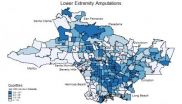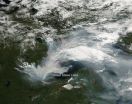(Press-News.org) It's no secret that poverty is bad for your health. Now a new UCLA study demonstrates that California diabetics who live in low-income neighborhoods are up to 10 times more likely to lose a toe, foot or leg than patients residing in more affluent areas of the state. Earlier diagnosis and proper treatment could prevent many of these amputations, the researchers say.
The study authors hope their findings, published in the August issue of Health Affairs, will motivate public agencies and medical providers to reach out to patients at risk of late intervention and inspire policymakers to adopt legislation to reduce barriers to care.
"I've stood at the bedsides of diabetic patients and listened to the surgical residents say, 'We have to cut your foot off to save your life,'" said lead author Dr. Carl Stevens, a clinical professor of medicine at the David Geffen School of Medicine at UCLA. "These patients are often the family breadwinners and parents of young children — people with many productive years ahead of them.
"When you have diabetes, where you live directly relates to whether you'll lose a limb to the disease," added Stevens, an emergency physician for 30 years at Harbor–UCLA Medical Center. "Millions of Californians have undergone preventable amputations due to poorly managed diabetes. We hope our findings spur policymakers nationwide to improve access to treatment by expanding Medicaid and other programs targeting low-income residents, as we did in California in 2014."
The authors used data from the UCLA Center for Health Policy Research's California Health Interview Survey, which estimated the prevalence of diabetes among low-income populations by ZIP code. They blended these statistics with household-income figures from the U.S. Census Bureau and hospital discharge data from the Office of Statewide Health Planning and Development that tracked diabetes-related amputations by ZIP code.
The result was a detailed set of maps showing diabetic amputation rates by neighborhood for patients 45 and older — the age range at greatest risk for amputation from disease complications.
"Neighborhoods with high amputation rates clustered geographically into hot spots with a greater concentration of households falling below the federal poverty level," said co-author Dylan Roby, director of health economics at the UCLA Center for Health Policy Research and an assistant professor at the UCLA Fielding School of Public Health. "Amputation rates in California were 10 times higher in the poorest neighborhoods, like Compton and East Los Angeles, than in the richest neighborhoods, such as Malibu and Beverly Hills."
The findings paint a grim picture.
In 2009, California doctors surgically removed nearly 8,000 legs, feet and toes from 6,800 people with diabetes. Roughly 1,000 of these patients underwent two or more amputations. On average, 20 diabetic Californians were wheeled into the operating room each day for an amputation.
The researchers found that not only did diabetic residents of low-income neighborhoods like San Fernando have a tenfold higher risk of at least one amputation, compared with patients in, say, tonier Hermosa Beach, but that race also played a significant role.
Less than 6 percent of diabetic Californians are African American, yet blacks accounted for nearly 13 percent of the patient population undergoing one or more amputations in 2009. Conversely, Asians made up 12 percent of the diabetic population yet had less than 5 percent of diabetes-related amputations that year.
Amputation patients were most likely to be black or non–English speaking, male, and older than 65.
"The U.S. spends more health care dollars per person than any country in the world," said co-author Dr. David Schriger, a professor of emergency medicine at the Geffen School of Medicine. "Yet we still can't organize our health care system in a way that gives everyone adequate treatment. Should we tolerate a tenfold disparity for the loss of a limb and a patient's ability to walk when we can prevent amputations with proper care?"
People with poorly managed diabetes often suffer from a compromised immune system. As a result, a blister or other foot injury may rapidly progress to a serious, even life-threatening infection. Early diagnosis, antibiotics and expert wound care can stop the process, but patients lacking access to treatment risk gangrene and blood infections that require immediate amputation.
The UCLA researchers' next step will be to tease out the most important factors contributing to amputation and to develop strategies for lowering the risk for diabetic people living in impoverished neighborhoods.
INFORMATION:
The research was supported by the Korein Foundation, the National Institutes of Health's National Center for Advancing Translational Science, and the UCLA Clinical and Translational Science Institute. Anna Davis and Dr. David Zingmond of UCLA, and Dr. Brian Raffetto of USC, were contributing authors.
Poor people with diabetes up to 10 times likelier to lose a limb than wealthier patients
Most amputations preventable with earlier medical care, UCLA researchers say
2014-08-04
ELSE PRESS RELEASES FROM THIS DATE:
Cost-saving effort in health care falls short of goals, study finds
2014-08-04
A pilot program intended to implement and test a cost-saving strategy for orthopedic procedures at hospitals in California failed to meet its goals, succumbing to recruitment challenges, regulatory uncertainty, administrative burden and concerns about financial risk, according to a new RAND Corporation study.
The outcome represents a disappointing effort to widely adopt bundled payments, a much-touted strategy that pays doctors and hospitals one fee for performing a procedure or caring for an illness. The strategy is seen as one of the most-promising ways to curb health ...
An embryonic cell's fate is sealed by the speed of a signal
2014-08-04
VIDEO:
To visualize cells' responses to the signals that ultimately lead them to choose a fate, the researchers engineered a protein involved in this response, Smad4, to glow. In response to...
Click here for more information.
When embryonic cells get the signal to specialize the call can come quickly. Or it can arrive slowly. Now, new research from Rockefeller University suggests the speed at which a cell in an embryo receives that signal has an unexpected influence on that ...
Scientists uncover combustion mechanism to better predict warming by wildfires
2014-08-04
Scientists have uncovered key attributes of so-called "brown carbon" from wildfires, airborne atmospheric particles that may have influenced current climate models that failed to take the material's warming effects into account. The work was described by a collaborative team of researchers from Los Alamos National Laboratory, Carnegie Mellon University and the University of Montana in the journal Nature Geosciences this week.
"Biomass burning and wildfires emit fine particulates that are toxic to humans and can warm or cool climate. While their toxicity is certain, their ...
Fires not slowing around Yellowknife
2014-08-04
Fires and the resultant smoke that comes from them are both just as widespread and heavy as they were in the month of July. Hundreds of fires dot the landscape and the Northwest Territories Live Fire map shows the extent of the wildfires and hot spots that have been reported. Fire danger around this area of the Northwest Territories remains in either the high or extreme range. On the live fire map, notated detections of new fires number in the dozens. These fires are ones having been detected within the last 24 hours. Residents of Yellowknife were witness to red lightning ...
'I cant figure out how to do this!'
2014-08-04
"Physics summer work, please help!!!," a post on Yahoo! Answers begins. "I cant figure out how to do this anywhere!!! Best answer awarded? Need help immediately!!!!!."
Most of the science and math queries on Yahoo! Answers resemble this one, although some are less hysterical. But they all make people who love science and teaching science cringe. It's not that they think the students are "cheating" by trying to google the answer, but rather that they know students who ask this kind of question are learning nothing and probably confirming a secret conviction that they're ...
Speedier diagnosis of diseases such as cancer likely thanks to new DNA analysis technique
2014-08-04
Researchers from McGill University and the Génome Québec Innovation Centre have achieved a technical breakthrough that should result in speedier diagnosis of cancer and various pre-natal conditions.
The key discovery, which is described online this week in the Proceedings of the National Academy of Sciences (PNAS), lies in a new tool developed by Professors Sabrina Leslie and Walter Reisner of McGill's Physics Department and their collaborator Dr. Rob Sladek of the Génome Québec Innovation Centre. It allows researchers to load long strands of DNA into a tunable nanoscale ...
In defense of mouse models for studying human disorders
2014-08-04
Mouse models of human diseases are essential research tools that are widely used in the medical sciences to increase our understanding of the pathogenesis and pathophysiology of various diseases, and to search for cures. Despite the widespread use of mice as animal models of disease, in 2013, Seok et al. reported that mouse models poorly mimic human inflammatory diseases, such as severe burn injury, sepsis, and acute infection, in terms of gene expression (PNAS 2013, 110(9), 3507-3523), which has been cited more than 400 times since its publication only 18 months ago. Their ...
Sulfur signals in Antarctic snow reveal clues to climate, past and future
2014-08-04
Sulfur signals in the Antarctic snow have revealed the importance of overlooked atmospheric chemistry for understanding climate, past and future.
Eruptions of huge volcanoes, the disruptive weather pattern known as El Niño, and a fire season from hell each left distinctive chemical marks in layers of snow excavated near the South Pole, researchers from the University of California, San Diego and France report in the Proceedings of the National Academy of Sciences the week of August 4.
Sorting out the chemical reactions that must have led to those traces revealed a process, ...
Overtreatment and undertreatment of patients with high blood pressure linked to kidney failure and death
2014-08-04
PASADENA, Calif., August 4, 2014 — The mantra for treatment for high blood pressure has been "the lower, the better," but that goal can potentially put patients at risk of kidney failure or death, according to a Kaiser Permanente study published today in the Journal of the American College of Cardiology.
Researchers examined the electronic health records of nearly 400,000 Kaiser Permanente patients in Southern California who were taking medications to treat high blood pressure from January 2006 through December 2010. They found that:
patients within the range between ...
A polypill strategy to improve global secondary cardiovascular prevention
2014-08-04
WASHINGTON (Aug. 4, 2014) — The polypill, a combination pill taken just once a day that includes key medications for secondary prevention of heart disease, may be an effective low-cost strategy to improve adherence to medication recommendations and reduce costs, according to researchers from Spain and New York, who reviewed research on the polypill.
The review article, A Polypill Strategy to Improve Global Secondary Cardiovascular Prevention, was published online today in the Journal of the American College of Cardiology and will appear in the August 12, 2014 print issue. ...
LAST 30 PRESS RELEASES:
UVA’s Jundong Li wins ICDM’S 2025 Tao Li Award for data mining, machine learning
UVA’s low-power, high-performance computer power player Mircea Stan earns National Academy of Inventors fellowship
Not playing by the rules: USU researcher explores filamentous algae dynamics in rivers
Do our body clocks influence our risk of dementia?
Anthropologists offer new evidence of bipedalism in long-debated fossil discovery
Safer receipt paper from wood
Dosage-sensitive genes suggest no whole-genome duplications in ancestral angiosperm
First ancient human herpesvirus genomes document their deep history with humans
Why Some Bacteria Survive Antibiotics and How to Stop Them - New study reveals that bacteria can survive antibiotic treatment through two fundamentally different “shutdown modes”
UCLA study links scar healing to dangerous placenta condition
CHANGE-seq-BE finds off-target changes in the genome from base editors
The Journal of Nuclear Medicine Ahead-of-Print Tip Sheet: January 2, 2026
Delayed or absent first dose of measles, mumps, and rubella vaccination
Trends in US preterm birth rates by household income and race and ethnicity
Study identifies potential biomarker linked to progression and brain inflammation in multiple sclerosis
Many mothers in Norway do not show up for postnatal check-ups
Researchers want to find out why quick clay is so unstable
Superradiant spins show teamwork at the quantum scale
Cleveland Clinic Research links tumor bacteria to immunotherapy resistance in head and neck cancer
First Editorial of 2026: Resisting AI slop
Joint ground- and space-based observations reveal Saturn-mass rogue planet
Inheritable genetic variant offers protection against blood cancer risk and progression
Pigs settled Pacific islands alongside early human voyagers
A Coral reef’s daily pulse reshapes microbes in surrounding waters
EAST Tokamak experiments exceed plasma density limit, offering new approach to fusion ignition
Groundbreaking discovery reveals Africa’s oldest cremation pyre and complex ritual practices
First breathing ‘lung-on-chip’ developed using genetically identical cells
How people moved pigs across the Pacific
Interaction of climate change and human activity and its impact on plant diversity in Qinghai-Tibet plateau
From addressing uncertainty to national strategy: an interpretation of Professor Lim Siong Guan’s views
[Press-News.org] Poor people with diabetes up to 10 times likelier to lose a limb than wealthier patientsMost amputations preventable with earlier medical care, UCLA researchers say









